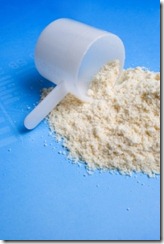Whey protein versus soy protein, part 1.
For years now, the issue over which protein is better has been hotly debated, by both professionals and fitness/nutrition enthusiasts. Here, instead of giving my personal opinion, I will present some of the facts so that you can make your own decision about which meets your personal needs. While there are many excellent protein supplement choices, this article will compare whey and soy as sources. Because of the scope of the argument, I will be dividing the discussion into “rounds”, two or three rounds per posting.
It goes without saying that soy is the best choice if you are a vegetarian or following a vegan lifestyle. And of course, you should take any food allergies into account.
____________________________________________________________________________________________________
A Quick Note – Protein and Nitrogen
Amino acids are the building blocks of protein. Amino acids consist of four elements – carbon, hydrogen, nitrogen, and oxygen.All three of the macro nutrients contain carbon, hydrogen and oxygen. Unlike carbohydrates and fats,however, protein also contains nitrogen.
This unique nature of proteins allows us to utilize the measures below to make decisions. Additional Facts About Protein
___________________________________________________________________________________________________
Soy Versus Whey – Which has a Better Biological Value?
The Biological Value (BV) method uses nitrogen retention quantify protein quality. The Biological Value provides a measure of the amount of nitrogen retained from consumption of protein compared to the amount of nitrogen consumed when a person is in a “fasted” state (the stomach is completely empty).
The Biological Value indicates both how digestible the protein is and how available the protein is for use by the body. Biological value began as a percentage – A whole egg rated at 100% nitrogen absorbed.
As time progressed, protein powders became better sources of protein, exposing a flaw in the BV measurement system. Today, the number is on an adjusted scale such that a whole egg is has a BV of 100. This allows some processed proteins to have biological values greater than 100. Obviously, the higher the number, the better.
How do the BV values compare in the soy versus whey protein debate?
Round 1 – Soy vs. Whey Protein
Soy Vs. Whey Protein
BV
Soy Protein Concentrate
74
Whey Protein
104
Round 1 of the Soy Protein versus Whey Protein debate goes to…
Whey Protein.
______________________________________________________________________________________________________
Soy Versus Whey – Which has a Better Net Protein Utilization?
Net Protein Utilization (NPU) is the amount of amino acids converted to protein inside the body versus the amount of amino acids from protein eaten.The NPU measures the ratio of protein consumed through a person’s diet, to the amount of nitrogen emission.
The value varies from 0 to 100 and is often interpreted as a percentage. A value of 100 means that the body uses 100% of the protein provided. Conversely, a value of 0 signifies that none of the nitrogen converts to protein in the body. Therefore, the higher the number, the better the protein.
How do the NPU values compare in the soy versus whey protein debate?
Round 2 – Soy vs. Whey Protein
Soy Vs. Whey Protein
NPU
Soy Protein Concentrate
61
Whey Protein
92
Round 2 of the Soy Protein versus Whey Protein debate goes to…
Whey Protein.
______________________________________________________________________________________________________
Soy Versus Whey – Which has a Better Protein Efficiency Ratio?
The protein efficiency ratio measures the gain in body weight divide by the weight of the protein consumed for infant laboratory rats.The FDA used the protein efficiency ratio to derive the recommended daily allowance of protein seen on food labels.
Some concerns with PER include the fact that rats utilize protein differently than humans, leading into some calculation errors. These errors cause a slight overestimation of animal protein and a slight underestimation of plant protein.
Also, PER measures only growth, and says nothing of maintenance. As a result, it might not be the best measure of the quality of protein for those of us attempting to burn fat.
How do the NPU values compare in the soy versus whey protein debate?
Any protein having greater than a 2.7 PER calculation is considered an excellent source of protein.
Round 3 – Soy vs. Whey Protein
Soy Vs. Whey Protein
PER
Soy Protein Concentrate
2.2
Whey Protein
3.2
Round 3 of the Soy Protein versus Whey Protein debate goes to…
Whey Protein.
_______________________________________________________________________________________________________
That’s all the time I have for now. At this point, it might seem that whey has a clear advantage. Rest assured, soy will be making a comeback in later articles in this series.
